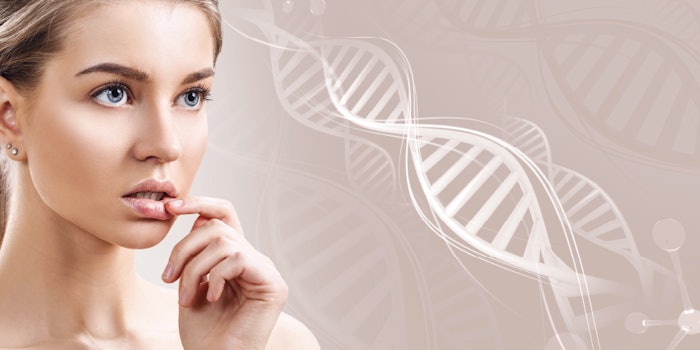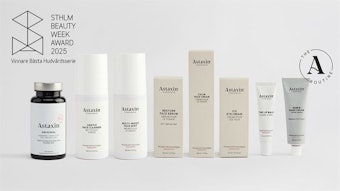
Collagen is a structural component of facial anatomy that serves as a framework to the skin providing substance tensile strength, regulation of cell adhesion and directs tissue development. The structural organization of collagen originates from functional fibers assembled via a complex process utilizing proteins and amino acids. Collagen’s fibrous protein are found in the extracellular matrix (ECM) and connective tissue of the skin.
The ECM is formed by unique protein families tasked with supplying structural integrity and several physiological functions forming a dense network throughout the dermis. The collagen family of proteins can be grouped into: fibril-forming collagens, fibril-associated collagens, network-forming collagens, anchoring fibrils, transmembrane collagens and basement membrane collagens.
Collagen 101
The human body consists largely of the collagen fibril-forming types. Collagen fibrils are made of collagen I and III in the skin, and are mainly determined by the existence of several amino acid chains with combined ratios of amino acids. Collagen is mainly produced by fibroblasts in the connective tissues, but numerous epithelial cells make certain types of collagens as well. With age, the ability to replenish collagen naturally decreases by about 1.5% per year. Collagen fibers in aged skin become thicker, shorter and result in a loss of type I collagen. As the density of collagen and elastin in the dermis declines, the structure and elasticity of the skin degrades, causing it to become thinner and more rigid.1
The body contains 28 types of collagens and consists of approximately 80%-90% of collagen type I, II or III. The collagen helix is formed by a network of fibers bound by the amino acids: lysine, glycine, proline, hydroxylysine, hydroxyproline and along with keratin and elastin, give the skin its strength. The skin requires a balanced ratio of amino acids to provide this structural composition of protein. Without amino acids, protein molecules and the complex matrix of amino acids will not fabricate collagen. Hydroxyproline is created by a modification of proline amino acids, oxygen and vitamin C, after the collagen chain is constructed. Our body does not manufacture vitamin C, and there are potential detrimental effects on the skin and to the body if the intake of vitamin C is inadequate. Several factors influence collagen production one’s lifetime including puberty, pregnancy, menopause, smoking, UV radiation, nutrient deficiencies and pollution.
By age 50, many women may lose up to half of the collagen from their skin, which is often compounded by not consuming enough protein for an extended period. Protein deficiency can also lead to muscle wasting (catabolism), poor wound healing, frequent infections, swelling under the eyes and ankles, hair breakage and hair loss.
Related: Pass the Collagen: A Nutritional Approach to Staying Youthful
Power to the Protein
Proteins are large molecules composed of complex chains of amino acids and are classified by the number of amino acids formed into a chain. The long polypeptide chains are joined in length by specific sequences, peptide bonds and sulfur amino acid (cysteine) bonds. More than 50 amino acids are supplied by proteins with typically 100 to 10,000 amino acids linked together to form structural units and fibrous proteins found in the skin, tendons, bone and muscle. Amino acids are essential for both dermal and epidermal structures and produce the extracellular proteins and enzymes needed for the synthesis of the epidermal barrier.
The essential amino acids for the body are: arginine, histidine, leucine, iso leucine, lysine, methionine, phenylalanine, threonine, tryptophan and valine. The non-essential amino acids are formed by essential amino acids carnitine, cysteine, glutamine, taurine and tyrosine.
Complete protein sources include proteins that provide all the essential amino acids, whereas incomplete protein sources are missing one or more essential amino acids. Essential amino acids must be included in the diet and consumed as food or supplements because the body cannot manufacture them. It is also necessary for dietary protein sources to offer both sufficient quality and quantity of amino acids to provide adequate ratio amounts for the amino acid profile.
Our protein levels are conserved during periods of total nutrient deprivation by mechanisms such as the recycling of amino acids, processing of proteins within the organelles, and cellular turnover of amino acids consuming tissues. A functional distinction cannot be made to differentiate between the impact of synthesized amino acid units because of tissue breakdown, and those that are utilized from a dietary source. The amino acid “pool” is influenced by the turnover of protein in the body, intake of dietary protein, synthesis of non-essential amino acids, and the collective status of the type of amino acids. Adequate protein intake is necessary to supply such indispensable amino acids in the body. It is also very important to note that it is not only the total protein gram count that substantiates the quality of protein intake, but also the total amino acid profile that is consumed.
Behold the Collagen Boom
In 2016, the collagen market was valued at an estimated $3.71 billion and is projected to reach $6.63 billion by 2025. Collagen supplements are non-regulated by the FDA, and controversially, may contain toxins and heavy metals.2 The range of collagen products available is overwhelming and includes drinks, milks, bars, powders, coffee creamers, gelatin, capsules and gummies. Regarding the skin, most are marketed as improving skin integrity and modulating skin aging.3 Notably, collagen cannot be absorbed in the digestive system unless it’s broken down into smaller amino acids. Collagen supplements are not actually collagen, but synthesized components of collagen derived from connective tissue, bones and other parts of cows, pigs, chicken and fish reduced to an absorbable form. A hydrolyzed collagen (HC) powder should be enriched in the specific amino acids: glycine, proline and hydroxyproline. HC has active mechanisms in the dermis via free amino acids providing building blocks for the formation of collagen and elastin fibers. Additionally, collagen oligopetides bind to receptors on the fibroblasts’ membrane stimulating the production of new collagen, elastin and hyaluronic acid.1
The quality of the HC is based on its average molecular size, which varies depending on the methodology used to extract it. For a collagen powder to be active in the skin, it must cross the intestinal barrier and reach the blood stream. Through the network of blood vessels, the collagen peptides and amino acids are then distributed to the dermis, where it has been proven they can remain up to 14 days.4 The rate of transport across the intestinal barrier is always in question with any supplement, as bioavailability and absorption may limit the efficacy of the HC in the skin. The body is provided collagen through our varied protein food sources, and no matter the type or quality of supplements consumed, they should not be considered a substitution for actual protein food components. Collagen supplements generally offer a favorable ratio of amino acids, but do not provide a complete amino acid profile. Unfortunately, we do not get to choose how our body will target and utilize a collagen supplement. Consuming foods high in collagen may provide your body with amino acids that will reassemble whatever protein it needs.
The available evidence regarding the types of collagens or their mechanism of assimilation to produce desired results and side effects have not been rigorously reviewed, synthesized, or proven by non- interest studies.5 Collagen supplements are not without potential side effects including: bloating, constipation, upset stomach, kidney stones, allergic reactions, drug interactions, skin breakouts and high histamine activity in histamine-sensitive individuals.
As collagen is considered an incomplete protein and is missing the amino acid tryptophan, tryptophan depletion has been implicated to lead to low serotonin (neurotransmitter and hormone), which has a huge impact on your mood.6,7
More Collagen More Protein
When it comes to protein and amino acid supplements, many experts suggest that instead of adding extra protein and amino acid supplements to high-protein diets, protein should be preferably received from whole foods, such as fish, eggs, dairy products, legumes and cereals, along with fibers and other food components supporting the well-being of both the host and their gut microbiota. Supplements should be utilized as an occasional resource to help improve athletic performance or support recovery in the case of nutrient imbalances confirmed through testing (See Protein Powder 101 Sidebar).8
Milk contains two main types of proteins which include whey (80%) and casein (20%). Both include all the essential amino acids making them a complete protein source. Branched chain amino acids (BCAAs) include leucine, isoleucine and valine, which are three of the essential amino acids. They make up a majority of muscle proteins (30%-40%). Research has found that leucine is the most significant when looking at muscle protein synthesis and exercise recovery.
When milk is curdled and strained, it produces a liquid byproduct which is known as whey. Whey is then processed and dried into a powder. Whey can be further processed into whey protein isolate, which has a higher protein concentration compared to whey. Plant-based protein powders are derived from soy, pea, hemp and brown rice. Soy is the only plant protein that is considered a complete protein since it contains all the essential amino acids. Plant-based protein powders are recommended for those with a milk allergy, vegans, vegetarians, or those with certain food sensitivities.9
Erin Madigan-Fleck, NMD, CDT, LMC, LEI, has more than 35 years of experience in the aesthetic and natural health industry. She is a naturopathic medical physician with a private practice, Naturophoria, in Atlanta. She is a member of the American Society for Nutrition and serves on the Education Commission for the International Association for Applied Corneotherapy. She the owner and founder of DermaEducationTV Post Graduate Esthetic Training and the Scientific Esthetics Symposium.











